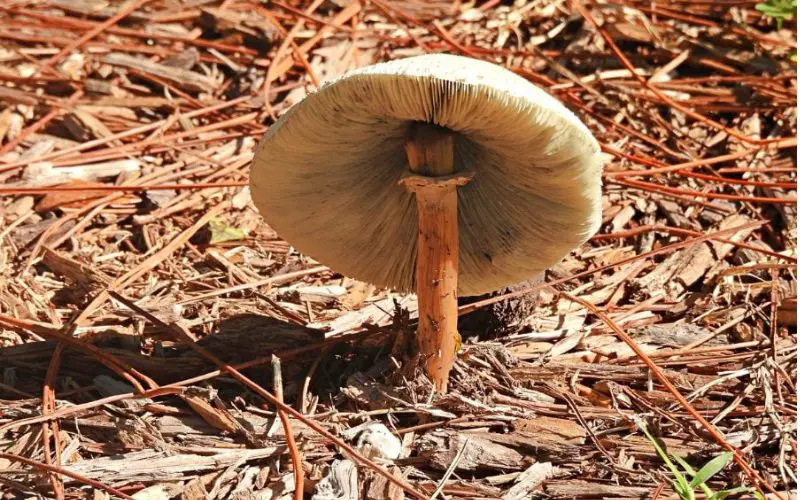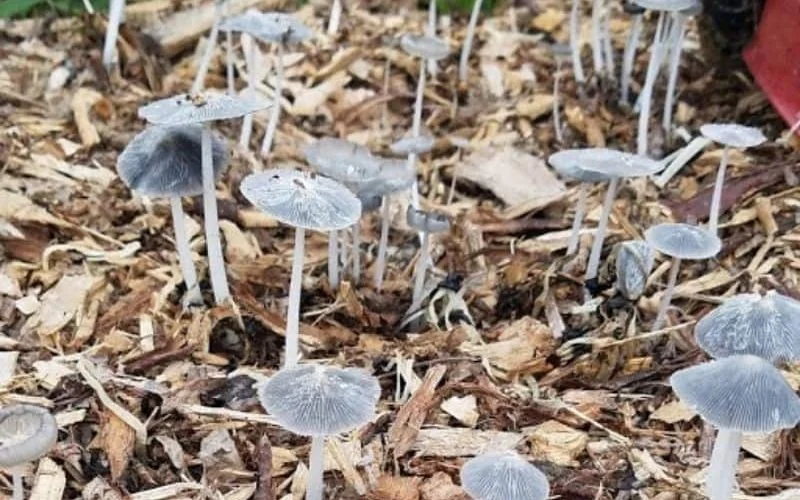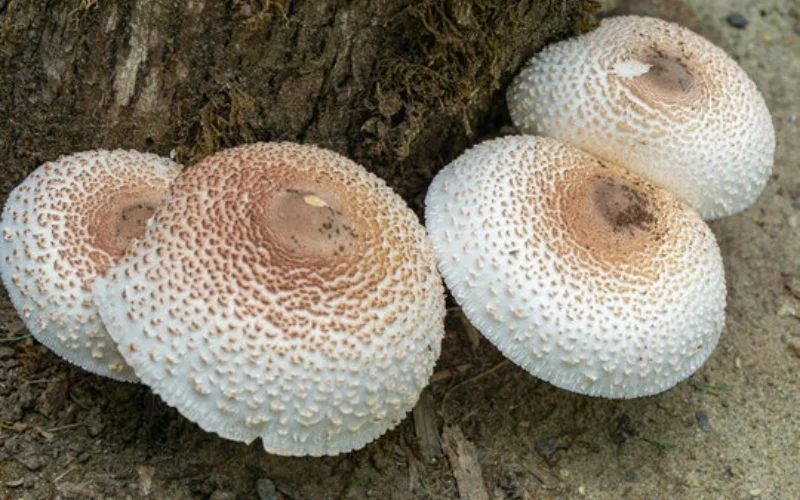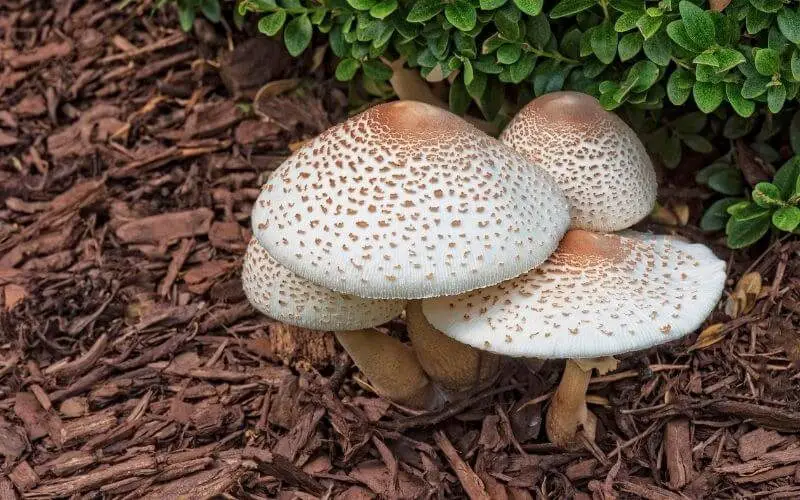Edible mushrooms make delicious delicacy, but there are so many types of mushrooms that are inedible and others that are poisonous to you and your pets.
By and large, most mushrooms that grow in mulches are not harmful to your plants, but some of them can pose a significant danger to you if you consume them because of their high toxicity.
While you might not pop any mushroom you find in your mulch, your pet, especially dogs that are very curious, might chow on them, and so, even if you don’t think that the mushroom in your mulch is poisonous, it is still a good idea to get rid of them for safety sakes.
The World Of Mushrooms

Mushrooms are fungi. They need animals and plants because of the way they obtain their food. Typically, animals refer to any living thing that cannot produce food, while plants can.
Fungi, on the other hand, have mycelium that grows into or around the food source, then secretes enzymes that digest the food externally, unlike animals that digest their food inside their bodies. The mycelium afterward absorbs the digested nutrients.
A mushroom is part of fungi that reproduces, so it is like a fruit of a plant, but instead of producing seeds, it produces millions of spores that are invisible to the human eyes and are formed under the mushroom cap.
When fungi spores are transferred by wind, water, animals, and humans to a suitable substrate such as mulch, wood, or soil, they begin to germinate and form mycelium, a network of microscopic rooting threads that penetrate their new food source.
After some time, the mushroom dies, but the mycelium continues to live for many years, and they stay alive by extracting nutrients and using them to produce mushrooms yearly.
Classification Of Mushroom Based On Their Toxicity
We can find thousands of mushroom species around, each of which has its characteristics. If you are to group mushrooms based on how poisonous they are, then you will have two groups which are:
- Edible mushroom
- Poisonous mushroom
Edible Mushrooms
Since not everyone can categorically tell an edible mushroom from one that is inedible or poisonous, it is best not to eat the mushroom you pick in your mulch or garden. The following species of mushroom can be found in mulches, and they are edible:
- Gimimo
- Bay bolete
- Black trumpet
- Portobello mushroom
- Gourmet mushroom
Edible mushrooms have large fruiting structures which are large enough to be seen with the eyes and picked. They are a very nutritious, cholesterol-free food containing some essential amino acids and B vitamins. Mushroom is a delicacy in many climes because of their subtle flavor and nice texture.
Most commercially grown mushrooms are:
- About 90% water.
- Less than 3% protein.
- Less than 5 percent carbohydrate.
- Less than 1 percent fat.
- About 1 percent mineral salts and vitamins.
Many people consume mushrooms for many reasons. Some consume them for their nutritional content, others for their medicinal value. Some medicinal mushrooms are eaten because of their nutraceutical effect and physiological benefit or protection against chronic disease.
There are also hallucinogenic mushrooms that act like psychedelic drugs. An example is psilocybin mushrooms which people consume for recreational or religious purposes.
These mushrooms are illegal in many places because they can produce severe nausea and disorientation. Many people don’t consider these mushrooms edible.
Poisonous Mushrooms
No known test can be used to show which mushroom is edible or poisonous, so if you need to learn more about mushrooms, never eat any mushrooms you see in your mulch or garden because they might be toxic.
Only about 1% of mushrooms found globally are truly poisonous, and some have caused deaths that could have been avoided.
Different poisonous mushrooms contain different toxins, which have the effect they have when consumed differently. When mushroom poisoning is suspected, immediate medical attention should be sought, as it can be the difference between life and death.
Types Of Mushroom Poisoning

Five main types of poisoning can occur from eating a poisonous mushroom
Amanita-type poisoning
This type of poisoning is caused by the Amanita phalloides group of mushrooms, which causes the most dangerous type of mushroom poisoning.
The toxins from these mushrooms accumulate in the liver and severely damage that organ, whicht is responsible for so much mushroom poisoning, especially in Europe.
Symptoms of Amanita-type poisoning include severe abdominal pain, violent vomiting, nausea, excessive thirst, cold sweats, cramps, and dehydration.
Muscarine-type poisoning
A. muscarine is the mushroom that is responsible for this poisoning. The toxins in this mushroom act as intoxicants, and the symptoms usually occur immediately after eating the mushroom.
You will notice symptoms like pupil contraction, reduced heart rate, lachrymation, salivation, blurred vision, perspiration, lowering of blood pressure, and asthmatic-like breathing.
A. Muscaria is used in religious rites because of symptoms like nervous excitement, shivering, the tendency to collapse, difficulty breathing, vomiting, diarrhea, and salivation.
Psychotropic poisoning
It is also known as hallucinogenic poisoning. It is found in mushrooms containing the toxin: psilocin and psilocybin, which are found in the species of Psilocybe, Conocybe, and Stropharia.
These toxins act on the nervous system and produce tactile sensation, distortion in vision, and mixed emotional feelings of happiness or depression. Some other people experience symptoms like an increased rate of heartbeat, vomiting, and hallucinations.
Coprinus poisoning
Coprinus group of mushrooms produces unpleasant but not dangerous symptoms of poisoning when consumed with alcohol. C. Micaceus and C. Atramentarius are examples of such mushrooms.
The symptoms of Coprinus poisoning include vomiting, reddening of the face, increased rate of heartbeat, and diarrhea.
Poisoning from external sources
This type of poisoning is not caused by the mushrooms directly but rather by the toxins that have built up in the mushroom.
These toxins can be the heavy metal that accumulates from mushrooms grown in polluted environments or places with radioactive waste. The symptoms of this poisoning depend on the causative agent.
Are Mushrooms That Grow In Mulch Poisonous?

The answer to this question is not a straight YES or No. It is because some mushrooms grow on edible mulch, others are not outrightly poisonous but still not edible, and others are just toxic.
Our advice is that every mushroom you see in your mulch should be considered inedible until or unless we get advised by a mycologist.
With over 14,000 species of mushrooms known to man, it can be hard to know which fungi are edible, toxic, or psychedelic. You can conduct a small test to find out if the particular mushroom in your much is poisonous.
All you need to do is to cut the mushroom. It tells you that the mushroom is poisonous if it turns green or purple. Poisonous mushrooms would burn or sting the tongue, and it doesn’t taste delicious, too, so much so that worms do not eat them.
A List Of Very Poisonous Mushrooms To Look Out For
Mushrooms in your lawn or garden are not harmful to your plants or grasses, even if they are poisonous, but you should remove all mushrooms you find around and adequately dispose of them. After all, kids and pets might ingest them because some of them are very colorful.
Here are some of the very poisonous mushrooms that there are:
Death Cap Mushroom
Other Names: Death cap Amanita
They are common in Europe but can also be found in other regions where they grow in oak forests. They have a white stem, white gills, and a white to light-green cap. It is so deadly that if an adult consumes just half a mushroom, the person can die.
Destroying Angel (Amanita Bisporigera)
Other Names: Fool’s mushroom
These highly toxic mushrooms are white in grassy meadows and woodlands.
False Parasol (Chlorophyllum molybdites)
Other Names: Green-spored Lepiota, vomiter
This mushroom is common in North America but poisonous and not deadly. Symptoms associated with its ingestion are diarrhea and other gastrointestinal issues. They are common in lawns and grass fields.
Ivory Funnel (Clitocybe dealbata)
Other Names: Sweating mushroom
This mushroom grows mainly in meadows and lawns. They ate white and were shaped like a funnel. They are moderately poisonous, and symptoms of their ingestion include abdominal pain, digestive disorder, salivation, and sweating.
Jack O’Lantern (Omphalotus illudens)
It is a giant mushroom that is orange in color, and it has multiple caps, and when it is freshly picked, it has green bioluminescence around the gills. They are mildly toxic since people who consume them complain of mild digestive problems.
Conclusion
Mushrooms are some of the most popular members of the fungi kingdom, mainly because thousands of species are known and because some are very delicious and have found their way into many cuisines.
Helpful Links:
- Why Am I Getting Mushroom in My Mulch?
- Top 10 Profitable Backyard Farming in The U.S
- How Do I Get Rid of Mushrooms in My Garden Bed?
However, many species of mushrooms, especially those found in your mulch, are very poisonous. So, never eat any mushrooms you find in your mulch. You may also want to check out What To Do With Old Mulch.
If you liked this article, then please follow us on Facebook, Instagram and Pinterest.

